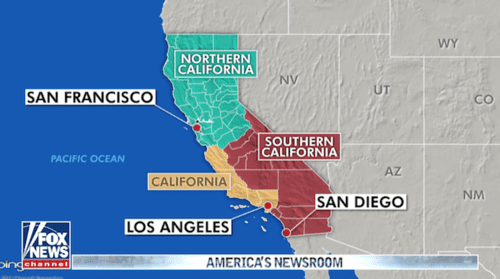


06/13/2018
It seems that a Silicon Valley billionaire thinks that chopping California into three separate states would “lead to better decision-making and more meaningful solutions closer to home”, according to the Cal3 website.
A look at the map suggests a more troublesome outcome — the threebie solution will lead to six Senators from the Californias rather than just two as we have now.
If the separation ran from north to south, creating a Western and Eastern California, then the more conservative valley would likely balance out the liberal coast zone in terms of political representation. But that is not what’s proposed.
The Cal3 website claims:
Californians deserve a more effective education system that isn’t failing our families, more reliable infrastructure that isn’t fracturing our communities, and more sensible taxes that aren’t stifling our opportunities.
Meanwhile back in the real world, California’s problems stem largely from being run entirely by Democrats at the state level and having the nation’s highest proportion of foreign-born residents (27 percent in 2016 according to PPIC), many of whom are poorly educated.
The California high school graduation rate for 2016 was only 77.4 percent, which belies the state’s reputation as a leading tech center. By comparison, agricultural Iowa had a 93 percent graduation rate.
In addition, excessive immigration leads to a permanent Democrat majority, something we should never forget.
Also, as an April 6, 2018 Orange County Register article noted, California faces a $1 trillion unfunded pension liability and lawmakers focus on foam and plastic straws. The Cal3 advocates say they want a “fresh start” but that pension bill is not going away, though none of the articles today about the initiative mentioned that cost directly.
Here’s the Fox News report on the proposed tripartite California:
And a newspaper article:
Proposal to split California into three states will be on November ballot, Washington Times, June 12, 2018
The six-state solution failed to catch on in California, but voters will now have an opportunity to decide whether the Golden State should be split three ways.
The “Cal 3” initiative sponsored by Silicon Valley billionaire Tim Draper qualified Tuesday for the November ballot, securing the necessary 365,880 valid signatures based on the state’s final random sample, according to Secretary of State Alex Padilla.
The ambitious longshot effort comes a few years after Mr. Draper failed to qualify his much-discussed “six Californians” initiative for the 2016 state ballot despite spending more than $5 million.
“This fall on Election Day, voters will get the chance to say that the status quo of ineffective, inefficient, and insular state government is taking Californians in the wrong direction,” said a post on the Cal 3 website.
Under the proposed initiative, the state would be split into three jurisdictions: Southern California, Northern California, and just plain California, which would run along the coastline from Los Angeles to Monterey.
If approved, the initiative would direct the governor to ask Congress for approval within 12 months to carve the state into three jurisdictions, after which the state legislature would be instructed to divide the state’s “assets and liabilities” three ways.
The three-state approach would give Californians a “fresh start” on issues like education, infrastructure and taxes, according to Mr. Draper.
“Cal 3 empowers Californians to direct the state legislature and U.S. Congress to create three new states, which will lead to better decision making and real solutions closer to home — like a dramatically more effective education system, more sensible taxes and more reliable roads,” said the website.
The proposal comes with Californians increasingly calling for the state to do something as frustration builds over the $1.3 trillion debt, mounting social problems, sharp political divisions between coastal and inland communities, and Sacramento’s ongoing feud with the Trump administration.